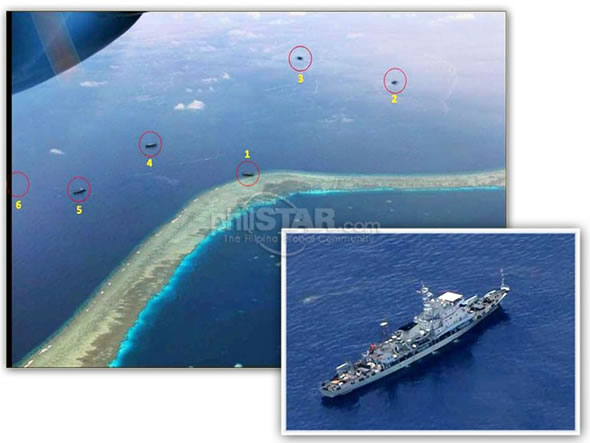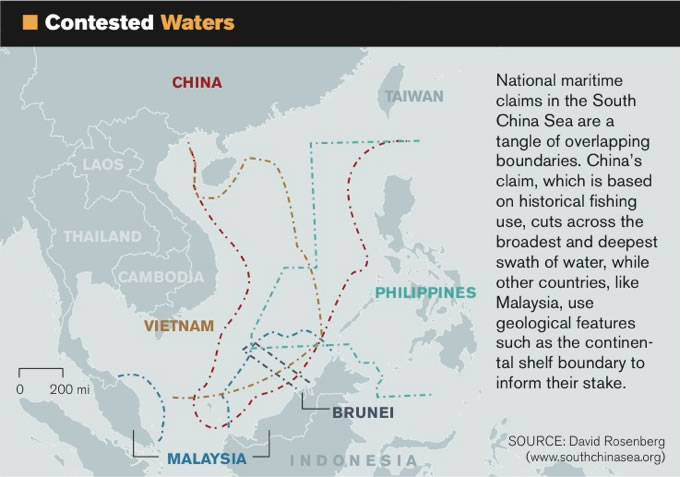On 13 July, the Chinese Defense Ministry announced on its website that a People’s Liberation Army Navy (PLAN) frigate ran aground in the Spratly Islands while conducting a routine patrol in the South China Sea. The frigate went aground on Half Moon Shoal located approximately 65 nautical miles west of the Philippine island of Palawan. The grounded frigate is believed to be No. 560, a Jianghu-class frigate, which has been linked to previous attempts to use intimidation to prevent Filipino fishing boats from entering the fishing grounds in the area.
The Chinese Defense Ministry said there were no injuries resulting from the grounding. Chinese claims that the frigate was conducting routine patrols was challenged on 13 July by a story carried in Australia’s Sydney Morning Herald. This story, quoting Western diplomatic sources, stated that the Chinese frigate was engaged in activities planned to discourage Filipino fishing vessels from entering the Spratlys.
Chinese officials announced on 15 July that the PLAN frigate that ran aground on Half Moon Shoal had been refloated and was headed for its homeport to complete a damage assessment. China’s Defense Ministry said in a statement that “the frigate which had run aground in waters near Half Moon Shoal successfully extricated itself with the help of a rescue team.” The statement went on to say that the bow of the vessel had sustained light damage and that all aboard were safe. Beijing further offered that return of the frigate to its homeport was being organized and claimed that the “incident caused no maritime pollution.”

Philippine defense sources confirmed that the frigate, accompanied by six additional Chinese vessels, had departed the area of the incident. Manila reaffirmed its contention that Half Moon Shoal lies well within its 200-nautical-mile exclusive economic zone, a zone recognized and guaranteed by international law. Departure of the Chinese vessels likely averted another face-to-face standoff with the Philippines, but tensions remain high and distrust of China remains strong.
The Spratlys form one of the largest island chains in the South China Sea. Beijing has long claimed sovereignty over virtually all the South China Sea region, a volatile claim that is disputed by no less than five other Pacific nations. The Philippines, Taiwan, Malaysia, Vietnam, and Brunei also lay claim to specific areas of the region. Of particular concern to China’s Pacific neighbors is the fact that Beijing’s claims infringe on their territorial waters, in some cases encompassing waters that are included in their internationally recognized exclusive economic zones.
With all of the competing property claims, the South China Sea has become a potential hotspot that some fear could rise to the level of armed hostility. In recent years the South China Sea has become a lucrative prize fueled by speculation that the region is endowed with extensive oil and gas reserves. The area is also a bountiful fishing ground. All six claimants to the region are determined to protect their territorial claims to guarantee their access to these energy sources and as protection of maritime transit and trade.

Beijing’s Pacific neighbors have become increasingly vociferous in their condemnation of what they call “China’s aggressive behavior and diplomatic bullying.” They have accused China of stationing warships in the area to frighten away fishing boats and generally interfere with peaceful maritime transit of the region.
The dispute has escalated in recent years and engaged the reluctant attention of nations far distant from the Asia-Pacific region. At the conclusion of a regional Association of Southeast Asian Nations (ASEAN) summit last week the attendees failed, for the first time in 45 years, to agree on a concluding statement to highlight diplomatic progress achieved during the summit. Association efforts to draft a joint code-of-conduct framework for future action, largely precipitated by the ongoing disputes over Pacific Isles, failed primarily due to Chinese dissension.
China, with support from Cambodia, prevented the 10-nation association from issuing a concluding statement that is customarily issued at the end of each summit to address member nation’s accomplishments and identify concerns to be addressed in future sessions. Cambodian Foreign Minister Hor Namhong defended his nation’s stance during the ASEAN summit in telling reporters that Cambodia’s position was based on principle and declared that during “the meeting of the ASEAN foreign ministers, we are not a tribunal to adjudicate who is right, who is wrong.”
China and the Philippines have engaged in several face-to-face encounters in the South China Sea, most recently in the Scarborough Shoals some 500 nautical miles north of Half Moon Shoal. Last year, the Philippines scrambled combat aircraft and warships to counter a Chinese threat to ram and sink a Filipino survey ship in the Reed Bank area of the region.
In June, Beijing announced the deployment of “combat-ready” vessels to areas of the South China Sea that China lays claim to. Beijing publicly announced that the Chinese government “vehemently opposed” and denied the legality of a Vietnamese law claiming sovereignty over the Paracel and Spratly Islands.
Beijing and Manila are still pursuing negotiations to end their dispute surrounding territorial claims to the Scarborough Shoal, a dispute that has dragged on for months and resulted in naval vessels from both nations meeting in a lengthy and tense face-to-face confrontation in the disputed area.
Manila announced on 15 July that the government was considering opening up bidding for oil and natural gas exploration rights in areas near the South China Sea to foreign investors. This announcement has also drawn a strong protest from the Chinese despite the fact that part of the area under consideration is only 34 miles off the coast of the Philippine’s Palawan Island.
With the Obama administration’s widely publicized “shift” to the Pacific, the island disputes have now taken on more of an international tone. Although the United States has publicly adopted a stance of neutrality in the South China Sea disputes, the US has agreed to bolster the Philippines with military hardware and increased the size of its military presence in the Philippines. The guiding principle, from an American standpoint, is to protect and defend freedom of navigation in all areas of the Pacific.
















